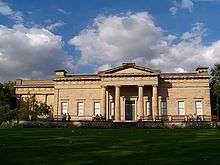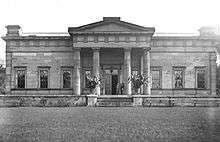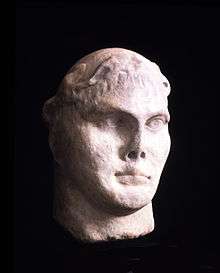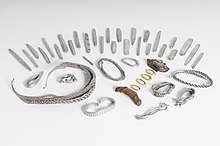Yorkshire Museum
 | |
 Location within North Yorkshire | |
| Established | 1830 |
|---|---|
| Location | Museum Gardens, York, England |
| Coordinates | 53°57′42″N 1°05′15″W / 53.96180°N 1.08744°W |
| Type | Archaeological and Natural Sciences Museum |
| Visitors | 98,000 (2015)[1] |
| Director | Reyahn King, York Museums Trust |
| Website | www.yorkshiremuseum.org.uk |
The Yorkshire Museum is a museum in York, England. It was opened in 1830, and has five permanent collections, covering biology, geology, archaeology, numismatics and astronomy.
History

The museum was founded by the Yorkshire Philosophical Society to accommodate their geological and archaeological collections, and was originally housed in Ousegate, York, until the site became too small. In 1828, the society received by royal grant, 10 acres (0.040 km2) of land formerly belonging to St Mary’s Abbey for the purposes of building a new museum. The main building of the museum is called the Yorkshire Museum; it was designed by William Wilkins in a Greek Revival style and is a Grade I listed building. It was officially opened in February 1830, which makes it one of the longest established museums in England. A condition of the royal grant was that the land surrounding the museum building should be a botanic gardens and one was created in the 1830s. The botanic gardens are now known as the Museum Gardens. On 26 September 1831, the inaugural meeting of the British Association for the Advancement of Science was held at the Yorkshire Museum.[2]
The Tempest Anderson Hall was built in 1912, as an annex to the museum, and is an early example of a reinforced concrete building. It is used as a conference venue and lecture theatre.
In 1960, the museum and gardens were given in trust to York City Council, the successor of which, the City of York Council, set up the York Museums Trust in 2002, to manage the York Castle Museum, York Art Gallery, the Yorkshire Museum and the Museum Gardens.[3][4]
The museum closed in November 2009 for a major refurbishment and reopened on Yorkshire Day on 1 August 2010. The £2 million scheme was largely carried out by the museum's own staff, who restructured and redecorated the interior of the building. As of January 2016, the museum has the following permanent exhibits: "Roman York – Meet the People of the Empire", "Capital of the North" (Anglian, Viking and Medieval York), and "Extinct: A way of life" a "fun, family-oriented gallery" featuring fossils, skeletons and animal specimens. There are also temporary exhibitions and a historic library and learning space.[5]
Collections
The four permanent collections at the museum all have English designated collection status, which means they are "pre-eminent collections of national and international importance".[6] The collection began in the 1820s, with the collection of animal bones and fossils from Kirkdale Cave.[7]
Biology
The biology collection contains 200,000 specimens, including both fauna and flora, with the majority of the collection made up of insects. There are two stuffed specimens of the extinct great auk, an almost complete skeleton of an extinct moa, and a large collection of specimens from the Yorkshire region including the remains of elephants, cave bears and hyena from Kirkdale Cave dated to the Quaternary period, around 125,000 years.
Geology
The geology collection contains over 112,500 specimens of rocks, minerals and fossils. Fossils make up the majority of the collection numbering over 100,000 samples, and include important specimens from the Carboniferous, Mesozoic and Tertiary periods.
Astronomy

The astronomy collection is mainly kept in the observatory in the museum gardens with some telescopes kept at the Castle Museum in York.[8] The observatory is staffed by volunteers.[9]
Archaeology

The archaeology collection has close to a million objects that date from around 500,000 BC to the 20th century. Most of the objects from the Roman, Anglo Scandinavian and Medieval periods are from the York and Yorkshire area. Following the 2010 refit of the museum, the first gallery displayed parts of the Roman collection, focusing on objects from Eboracum (Roman York). A statue of the Roman God Mars is prominently displayed, and there is an interactive display describing the lives of some of the Romans whose remains have been found in York.[10] The final record of the famous lost Roman legion, the ninth legion, is on display as part of the Roman gallery. The stone inscription, which has been dated to Trajan's twelfth year as emperor, between 10 December 107 and 9 December 108, commemorates the legion's rebuilding in stone of the south-eastern wall of Eboracum's legionary fortress.[11] The BBC reports that "Experts have described it the finest example of Romano British inscription in existence".[11]
The museum houses some collections of forged prehistoric tools by the Yorkshire forger, Flint Jack.
Notable collections
Geological
Prehistoric
- The Star Carr Pendant, the oldest Mesolithic art in Britain.[12]
Roman
- The Wold Newton hoard, a hoard of 1,857 coins dating from the early 4th century AD.
- The Head of Constantine the Great, a fragment of a marble statue of the Roman Emperor Constantine the Great
Early Medieval
- The Coppergate Helmet, an 8th century helmet found in York.
- The Ormside Bowl, a silvert-gilt bowl from Cumbria.
- The Bedale Hoard, a hoard of Viking silver jewellery and an Anglo-Saxon sword.[13]
- The Escrick ring, an Anglo-Saxon gold and sapphire finger ring.
- The Gilling sword, a late Anglo-Saxon sword found in a river.
- The Vale of York hoard, a 10th-century niello silver-gilt vessel containing coins and jewellery. It was valued at £1,082,000, and acquired jointly by the British Museum and the York Museums Trust. After being cleaned by the conservation department of the British Museum, it was displayed at the Yorkshire Museum from 17 September 2009, for a period of six weeks before moving to the British Museum.[14][15] The hoard was re-displayed at the Yorkshire Museum in 2015.[16]
Medieval
- The Middleham Jewel, a gold, diamond-shaped pendant set with a sapphire and engraved with a picture of the Christian Trinity on the front, and one of the Nativity of Jesus on the back.[17][18][19]
- The Cawood sword.[20]
- The Medieval Shrine of Saint William of York.[21]
- Objects from the archaeology collection
 Bun of Roman hair from the late third to early fourth century
Bun of Roman hair from the late third to early fourth century- Ormside bowl
 The front of the Middleham Jewel showing the Crucifixion of Jesus
The front of the Middleham Jewel showing the Crucifixion of Jesus The 8th century Coppergate Helmet
The 8th century Coppergate Helmet- The 9th century Gilling sword with silver decorated handle
 Carved Medieval Boss from St. Mary's Abbey
Carved Medieval Boss from St. Mary's Abbey Marble bust of the Roman Emperor Constantine the Great
Marble bust of the Roman Emperor Constantine the Great The Bedale Hoard of Viking silver and gold
The Bedale Hoard of Viking silver and gold
Events
The museum has 'Finds Days' in the main Yorkshire Museum building where members of the national British Portable Antiquities Scheme and museum staff will identify objects brought to them by members of the public. The information is also recorded to help build up a more complete archaeological picture of the past.[22]
Exhibitions
The museum has hosted many exhibitions since its inception.
1970s
The 1976 exhibition "The Viking Kingdom of York" was seen by over 78,000 visitors.[23]
1980s
The Coppergate helmet was first put onto display in a permanent gallery space in 1980 following a £30,000 grant from the British Museum as part of the "International Viking Exhibition".[23]
A third successful Viking exhibition, "The Vikings in England" was opened by the Prince of Wales on 30 March 1982 and was seen by over 235,000 visitors before it closed in October of the same year. This exhibition was awarded the European Museum of the Year Special Exhibition Award as a result of the presentation of the exhibition in the Museum and for additional educational projects organised by the then Keeper Elizabeth Hartley.[23]
2000s
The 2006 exhibition Constantine the Great: York's Roman Emperor was described as "the most important archaeological-historical loan exhibition to have been held in a provincial British museum".[24] It attracted over 58,000 visitors.[25]
2010s
The facial reconstruction of King Richard III was displayed in the museum from July–October 2013 as part of a national tour.[26]
A Shakespearean First Folio was on display in the Medieval gallery in 2014.[27]
In 2015 the museum first displayed the oldest Sauropod fossil from the Yorkshire coast, nicknamed 'Alan the Dinosaur'.[28]
In 2016 a recently discovered, unique Mesolithic pendant from Star Carr first went on public display.[29]
In 2017 the Museum hosted the first stage of a touring exhibition titled 'Viking: Rediscover the Legend', opened by Alice Roberts.[30] The exhibition is co-curated by the British Museum and will subsequently travel to the Atkinson Art Gallery and Library in Southport, Aberdeen Art Gallery, Norwich Castle Museum, and the University of Nottingham.[31][32] The exhibition was awarded the 'Excellence in Media Arts' award at the 2017 York Culture Awards.[33]
In April 2018, Yorkshire's Jurassic World exhibition, including marine and land fossils from Yorkshire and elsewhere, was opened by David Attenborough.[34][35]
Keepers and Curators
The museum has had many keepers, curators and honorary curators over its lifetime.
Keepers
- John Phillips - Keeper (1826-1844)
- Edward Charlesworth - Keeper (1844-1858)
- Charles Wakefield - Keeper (1858, 1870-1878)
- William Dallas - Keeper (1858-1868)
- John-Clay Purves - Keeper (1878-1880)
- Walter Keeping - Keeper (1880-1883)
- Henry Maurice Platnauer - Keeper (1883-1904)
- Oxley Grabham - Keeper (1904-1919)
- Walter Edward Collinge - Keeper (1921-1940)
- George Willmot - Keeper (1950-1970)
- Elizabeth Hartley - Keeper of Archaeology (1971-2007)
- Barbara Pyrah - Keeper of Geology
Honorary Curators
- Charles Wellbeloved - Honorary Curator of Antiquities
- Walter Harvey Brook - Honorary Curator of Medieval Architecture
References
- ↑ "York Museums and Gallery Trusts: Report and Financial Statements, Year Ending 31st March 2015" (PDF). York Museums Trust. 2015. Retrieved 3 February 2017.
- ↑ Willis, Ronald (1988). The illustrated portrait of York (4th ed.). Robert Hale Limited. p. 176. ISBN 0-7090-3468-7.
- ↑ "Yorkshire Philosophical Society history". Yorkshire Philosophical Society. Retrieved 31 December 2014.
- ↑ "York Museum Gardens". York Museums Trust. Retrieved 31 December 2014.
- ↑ "Exhibitions". Yorkshire Museum website. York Museums Trust. Retrieved 21 January 2016.
- ↑ "MLA Programmes designation". The Museums, Libraries and Archives Council. 2007. Archived from the original on 22 August 2007. Retrieved 4 September 2007.
- ↑ Pearce, Susan M. (1996). Exploring science in museums. Continuum International Publishing Group. pp. 35–39. ISBN 978-0-485-90006-4.
- ↑ "Biology". "Geology". and "Astronomy". York Museums Trust. 2006. Retrieved 8 September 2007.
- ↑ Ashworth, Ian. "Observatory volunteers". Archived from the original on 3 November 2014. Retrieved 3 November 2014.
- ↑ Morrison, Andrew (25 October 2010). "The Yorkshire Museum Refit: Did it "Let the Light In"?". The University of York. Retrieved 2 March 2012.
- 1 2 "Yorkshire Museum marks 'lost' Roman legion". BBC. 29 March 2011. Retrieved 2 March 2012.
- ↑ "Yorkshire Stone Age pendant goes on display". BBC News Online. 26 February 2016. Retrieved 16 February 2018.
- ↑ Laycock, Mike (13 December 2014). "Bedale Hoard back on display at Yorkshire Museum". Yorkpress.co.uk. Retrieved 7 February 2017.
- ↑ Timpson, Trevor (17 September 2009). "BBC News Channel". Getting the most out of treasure. Retrieved 20 September 2009.
- ↑ "Viking Hoard". Yorkshire Museum. 1 September 2009. Retrieved 20 September 2009.
- ↑ Pantry, Lyndsey (2 July 2015). "'Once in a lifetime' Viking hoard back on display". Yorkshire Post. Leeds. Retrieved 21 January 2016.
- ↑ "The Middleham Jewel". The Art Fund. Retrieved 13 October 2007.
- ↑ "Archaeology". York Museums Trust. 2006. Retrieved 24 June 2007.
- ↑ Cherry, John (1994). The Middleham Jewel and Ring. The Yorkshire Museum. pp. 4 and 24–26. ISBN 0-905807-12-X.
- ↑ Lewis, Haydn (18 December 2007). "Return of the Viking sword". Yorkpress.co.uk. Retrieved 7 February 2017.
- ↑ Harris, Richard (8 June 2010). "St William of York shrines on display for first time in 400 years". Yorkpress.co.uk. Retrieved 7 February 2017.
- ↑ "YMT: Portable Antiquities Scheme". York Museums Trust. Retrieved 16 February 2018.
- 1 2 3 Pyrah, B. J. (1988). "A Modern Museum (1970-1988)". The history of the Yorkshire Museum and its geological collections. North Yorkshire County Council. pp. 134–148. ISBN 1850720428.
- ↑ Grahame Soffe (October 2006). "Constantine the Great at York" (PDF). Association of Roman Archaeology Bulletin. 17: 38–40.
- ↑ Barnes, J. (2007). "Yorkshire Museum and Gardens 2006". Yorkshire Philosophical Society Annual Report for the Year 2007. Yorkshire Philosophical Society: 39.
- ↑ "Richard III's replica head on show in York". BBC News. 19 July 2013. Retrieved 16 February 2018.
- ↑ Laycock, M. "Shakespeare's First Folio goes on display at the Yorkshire Museum". York Press. Retrieved 16 February 2018.
- ↑ "Britain's oldest dinosaur fossil found on North Yorkshire coast". The Guardian. 1 June 2015. Retrieved 16 February 2018.
- ↑ "Yorkshire Stone Age pendant goes on display". BBC News. 26 February 2016. Retrieved 16 February 2018.
- ↑ Lewis, H. (19 May 2017). "TV professor opens York museum's Viking exhibition". Retrieved 16 February 2018.
- ↑ Lewis, S. (12 May 2017). "Face to face with the Vikings". York Press. Retrieved 24 May 2017.
- ↑ "A new understanding of the Vikings". Minster FM News. 18 May 2017. Retrieved 24 May 2017.
- ↑ "The 2017 Winners". York Culture Awards. Retrieved 16 February 2018.
- ↑ Laycock, M. (23 January 2018). "Sir David Attenborough to open York Jurassic exhibition". York Press. Retrieved 16 February 2018.
- ↑ Graham Lawton (21 April 2018). "Here be sea dragons". New Scientist. p. 46.
External links
| Wikimedia Commons has media related to Yorkshire Museum. |